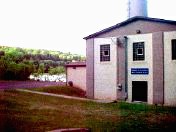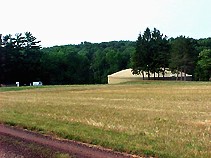DRINKING WATER PRE-TREATMENT
The water treatment process described below
is specific to the Water Filtration Plant of Sellersville, PA.
Other treatment processes may operate in a slightly different
manner. The water for a municipality (borough, town, or township)
in our region of Southeastern PA comes from a reservoir and three
deep wells. Several municipal wells are owned by each town in
our school district. While some individual home owners and businesses
also have private wells, we will concentrate here on water supplied
by a municipality.
 |
|
 |
| Water filtration plant
located at 627 Catch basin Road in Sellersville, PA. The filtration plant
capacity is 16,000,000 gallons. The water in the background is the reservoir. |
|
Ground level water storage
tank located on Ridge Road in West Rockhill Township holds 1,100,000 gallons.
This new tank was added when new laws required the cleaned water to be
covered. |
Water from the reservoir needs to be filtered
to remove impurities. The first step of filtration is the sand
filter process. In this process, water is drawn from the impounding
basin(reservoir)at 480 gallons per minute. From there, it is pumped
into a mixing chamber. Here, aluminum sulfate (alum), carbon (used
to control odor and improve taste), cat floc (which helps the
alum work beter), and chlorine are combined with the water. This
mix flows into the rear of the basin where the floc collects impurities
which then settle out in the settling basin, while the chlorine
kills bacteria in the raw water.
After this, the water passes through two
sand/gravel filters and into a well beneath the water filtration
plant. Lime (to adjust the pH) and more chlorine (to kill bacteria)
are added in this well. Then the water runs through a water main
to the water storage tank, which is located about a mile from
the plant. Water is then pumped to the community through a piped
water distribution system.
 |
Sellersville
also has 3 deep wells which supply 40% of the borough's water.
This water does not need to be filtered. Chlorine is added to
kill bacteria, and the water then goes directly to the water
distribution system. This photo shows the pump house for well
#5 on Ninth Street. |

